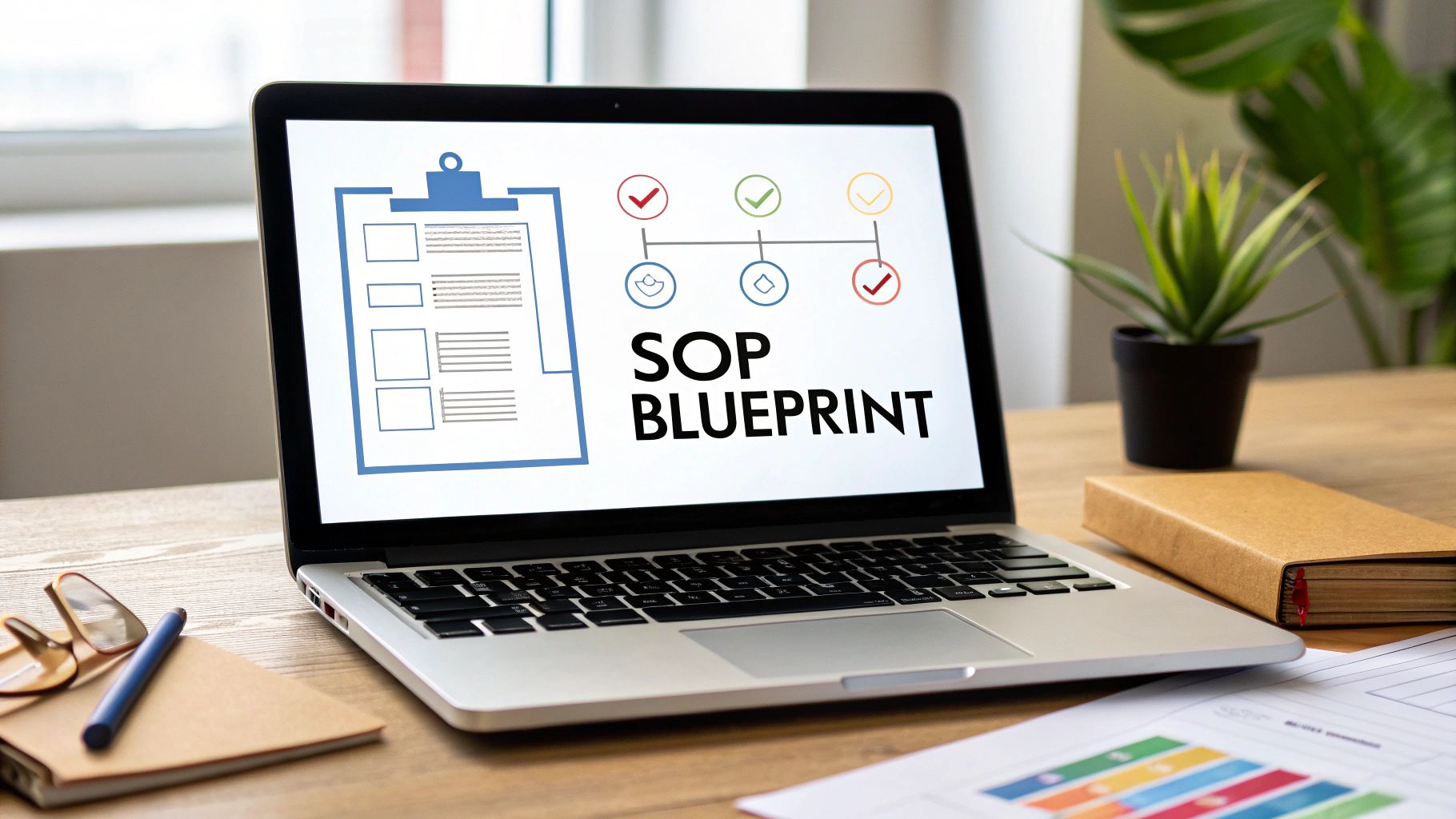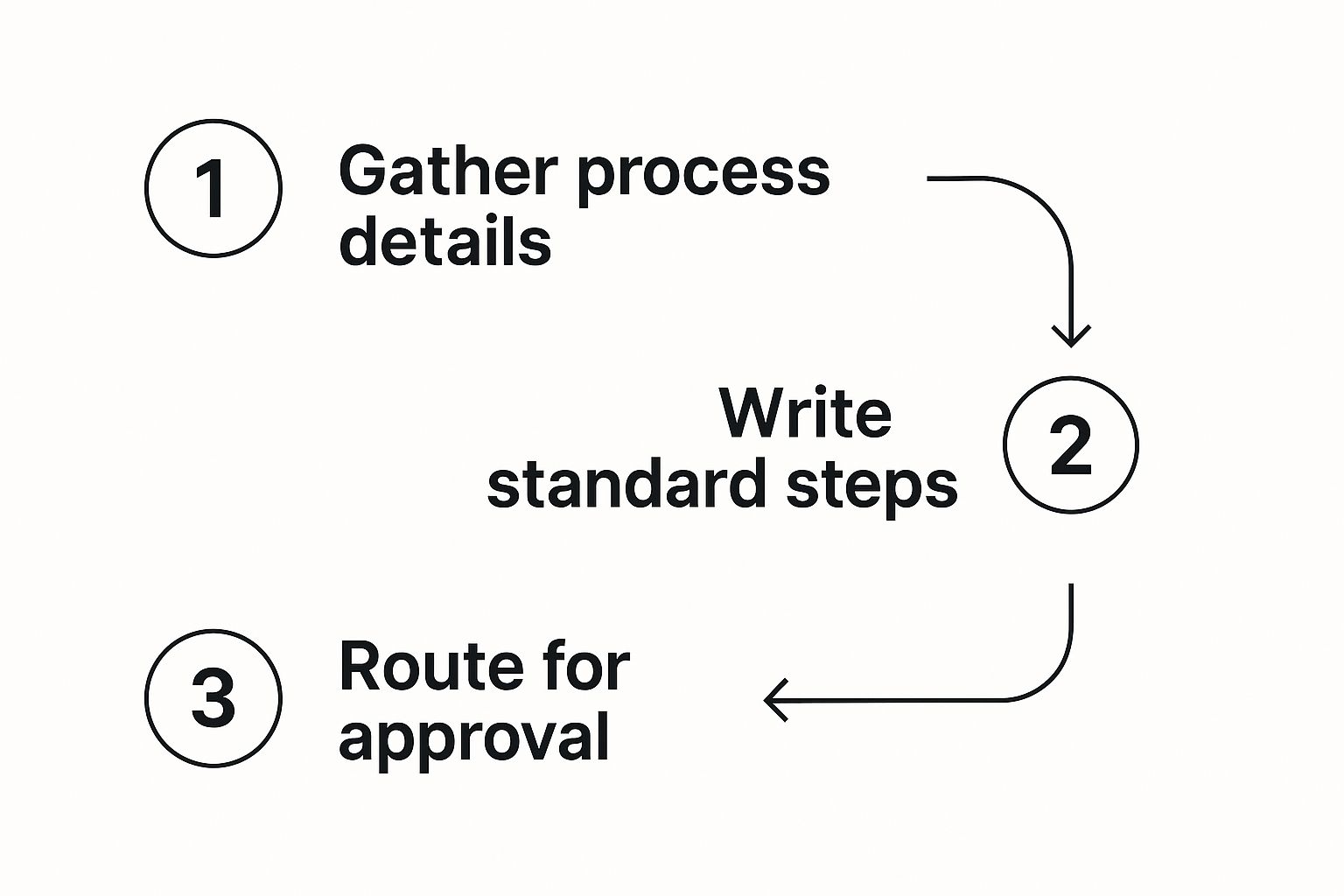Stay Updated with Everything about MDS
Thank you! Your submission has been received!
Oops! Something went wrong while submitting the form.

Chilat Doina
October 7, 2025
Ever feel like you're stuck solving the same problems over and over? Like you’re playing a daily game of operational whack-a-mole? That's the feeling of a business running without a playbook.
Creating standard operating procedures (SOPs) is how you finally break that cycle. It's about documenting your essential processes to ensure tasks get done the right way, every single time. This is the secret to swapping operational chaos for a system built to scale.
That constant feeling of putting out fires isn't a sign of bad sales—it’s a symptom of operational friction. Inconsistent customer service, messy fulfillment, and painful team onboarding all point back to one thing: a business running on unwritten rules and "tribal knowledge."
This is the invisible growth ceiling so many e-commerce founders hit. They blame everything else before realizing the root cause is a lack of documented systems.
It's easy to push documentation into the 'important but not urgent' pile when you're dealing with the daily grind. But here’s the hard truth: avoiding it is a massive risk. The U.S. Bureau of Labor Statistics reports that about 20% of new businesses fail within two years, and a staggering 45% shutter within five. A major contributor? A lack of clear, repeatable processes.
The table below shows the real-world shift that happens when a business gets serious about its systems. It's a move away from reactive problem-solving toward proactive, strategic growth.
Moving from the left column to the right isn't just about efficiency; it's about building a resilient brand that can handle growth without you, the founder, being the single point of failure.
I get it—building out SOPs feels like a huge upfront time investment. But the return is massive. You're building a system that lets you delegate with genuine confidence, ensuring every customer gets the same fantastic brand experience, no matter who's handling the task.
This is the fundamental transition every founder needs to make if they want to stop working in the business and start working on it.
The real magic of an SOP is its ability to turn a complex, multi-step task into a simple, repeatable checklist. This clarity doesn't just cut down on errors; it empowers your team. They stop guessing and interrupting you for answers, which frees up your mental bandwidth for high-level strategy.
Key Takeaway: SOPs aren't about creating corporate bureaucracy. They're about creating freedom—freedom from repetitive questions, freedom from inconsistent results, and the freedom to scale your operations without everything falling apart.
Ultimately, well-defined procedures do more than just keep things consistent; they unlock entirely new levels of efficiency. Once every step of a task is clearly mapped out, you can finally spot the bottlenecks and find opportunities to improve. Our guide on how to improve operational efficiency dives much deeper into these strategies.
Think of it this way: SOPs are the first step toward smart automation. They structure your tasks, laying the groundwork for greater efficiency and, eventually, for automating repetitive tasks to boost productivity.
Just imagine the practical impact:
By documenting your core functions, you’re not just writing things down. You're building a resilient, efficient machine that can handle growth without your constant oversight.

The thought of documenting your entire business is enough to make anyone freeze up. So let's get one thing straight: don't even try.
The real secret to building out your SOPs is to start small and be strategic. You aren't trying to create a massive, all-knowing library overnight. The goal is to score the quickest wins by solving your biggest, most repetitive headaches first.
Think of it as a "process audit." The procedures crying out for documentation are the ones already screaming for your attention. They’re the repetitive questions clogging your inbox, the costly shipping errors, and the wildly inconsistent customer support replies. Your daily frustrations are the roadmap.
So, where are the fires? Grab a notebook or open a fresh doc and get brutally honest with yourself. What tasks, if done wrong, cost you the most money? Which questions do you or your senior team members end up answering over and over again, every single day?
As you brainstorm, think about these common e-commerce pain points:
These are the perfect places to start. Creating an SOP for any of these delivers an immediate, tangible return on the time you invest.
Okay, you’ve got a list of potential SOPs. Now what? You have to prioritize, because not all tasks are created equal. I’m a big fan of the Impact/Effort Matrix for this. It’s a simple way to visualize which SOPs will give you the most bang for your buck.
Try to sort each potential SOP into one of four buckets:
Expert Tip: Start with a process that directly touches the customer experience. An SOP for "Handling Damaged Product Complaints" can immediately cut down on negative reviews and boost retention. It's a great way to show your team the real-world value of these documents from day one.
As you start pinning down these key processes, you’re also laying the groundwork for a more organized, scalable team. Documenting roles and responsibilities is the logical next step, and it's absolutely critical for growth. If you want to dive deeper, our guide on building an effective e-commerce team structure shows how clear roles are the bedrock of a thriving business.
The key is to focus on any task performed by more than one person or any task you plan to delegate soon. When you target these shared responsibilities, you build consistency and give your team members the confidence to work autonomously. This is how you finally start untangling yourself from the day-to-day grind and get back to focusing on the big picture.
An SOP that no one can find, understand, or follow is just digital clutter. Seriously. The goal isn't just to write down a process; it's to create a living guide your team will actually use. Moving beyond a simple text document is the first step toward making your procedures genuinely helpful.
The format you choose should directly match the complexity of the task. A simple checklist is perfect for end-of-day closing tasks, but you'll want a detailed, step-by-step guide with screenshots for processing customer refunds. Need to show someone how to use a specific software feature? A quick video tutorial will always be more effective.
One size does not fit all. I've seen too many founders try to force every single procedure into the same template, and it always leads to confusing and ineffective SOPs. The key is to match the format to the job at hand.
Think about how your team members will consume this information. Are they sitting at a desk or hustling on the warehouse floor? Do they need a quick reminder or in-depth instructions?
Let's break down the most common formats I've seen work well:
Simple Checklists: These are perfect for routine tasks that need verification but little explanation. The checkbox format is brilliant for making sure no step is missed. Think daily social media posting, warehouse opening procedures, or end-of-day financial reconciliation.
Step-by-Step Guides: This is the classic format, ideal for linear processes that require a bit more detail. Use numbered or bulleted lists, and for the love of clarity, embed screenshots or short GIFs to explain complex steps. This is your go-to for tasks like "How to Process a Product Return" or "Onboarding a New Virtual Assistant."

Flowcharts: Pull out a flowchart when a process has multiple decision points or outcomes. They are basically visual roadmaps for troubleshooting. For example, a "Customer Complaint Escalation" flowchart can guide your support team through different scenarios based on the customer's specific issue.
Video Tutorials: Nothing beats a short screen recording for software-based tasks. Instead of writing out a dozen steps on how to update a product listing in Shopify, a 90-second video is faster to create and so much easier for your team to follow.
Once you know the formats you need, you have to decide where these SOPs are going to live. The tool you choose is just as important as the content itself. A clunky, hard-to-access system will guarantee your SOPs are never used.
For a broader framework to house your procedures, you might want to explore some pre-built operations manual templates. These can provide a great starting point so you're not staring at a blank page.
Here’s a quick comparison of the common options for e-commerce brands:
My Advice: Start with a collaborative tool like Notion. It strikes the perfect balance between flexibility and structure. You can create a centralized, searchable knowledge base that houses checklists, step-by-step guides, and embedded videos all in one place.
The market for this stuff is booming, which shows a massive shift toward digital process documentation. The global market was valued at USD 124.8 billion in 2023 and is projected to explode to USD 914.9 billion by 2032. A key driver is the adoption of mobile-friendly tools that give teams on-the-go access to crucial info—a trend every e-commerce founder should be paying attention to.
Ultimately, the best tool is the one your team will use consistently. If you're running an Amazon-centric business, you'll also want to ensure your chosen system plays nice with your existing tech stack. For more on this, check out our guide on essential https://milliondollarsellers.com/blog/tools-for-amazon-fba-sellers. The right platform makes updates easy, ensuring your SOPs remain living guides, not digital dust collectors.
Alright, let's get our hands dirty and build a high-impact SOP from the ground up.
Knowing you need SOPs is one thing; actually structuring them so your team can follow along without getting confused is a whole different ball game. A truly great SOP is more than just a list of steps—it needs a clear purpose, a defined scope, and specific roles to be effective.
To make this real, we’ll draft an SOP for a classic e-commerce headache: "How to Handle a Damaged Product Complaint." This is a big one. Getting it right directly impacts customer satisfaction, your brand's reputation, and ultimately, your bottom line.
Before you write a single step, you have to lock in the fundamentals. Skip this, and your instructions will float in a void of context, leaving your team to just follow a robotic checklist instead of understanding the bigger picture.
Kick things off by answering these core questions:
Think of this initial setup as the guardrails for the entire document. It gets everyone on the same page from the get-go.
Now for the main event—the actual procedure. The golden rule here? Write from the end-user's perspective. Use simple, direct language and ditch the internal jargon. Seriously, write it as if you're explaining the process to a brand-new hire on their very first day.
This infographic breaks down the general flow for drafting any SOP, from gathering the initial details to getting the final sign-off.

As you can see, writing the steps is just one piece of a much larger, more structured process that ensures quality and team buy-in.
Let's break down the actual steps for our damaged product example:
Notice how every step is a clear, distinct action. To make this even more foolproof, use visuals. Annotated screenshots of your Shopify screen for step #3 or a simple flowchart for step #4 can make these instructions impossible to misinterpret.
Pro Tip: Your team's biggest questions will always come from edge cases. Get ahead of them by building in "what if" scenarios. For example, add a sub-bullet: "What if the customer cannot provide a photo? Escalate to the Support Manager for a decision." That tiny addition prevents a minor snag from becoming a major bottleneck.
To make sure your SOP is complete, scannable, and actually useful, it needs to have a few key elements every single time. The table below breaks down the must-haves for any SOP that's built to last.
Essential Components of a High-Impact SOP
When you consistently include these components, you’re not just writing a list of instructions. You’re building a professional tool that supports your team, drives consistency, and scales right alongside your business. It’s a blueprint that pays dividends in both efficiency and customer loyalty.

Let's be real: writing an SOP is just the first step. The real magic happens when your team actually uses it and the document grows with your business. An SOP gathering digital dust in a forgotten folder is completely worthless. The goal here is to create a living, breathing resource that powers consistency in your day-to-day operations.
This is where your carefully crafted document meets the real world. A successful rollout isn't just about dropping a new PDF in your team's Slack channel and hoping for the best. It’s a deliberate process of training, getting feedback, and building a culture where SOPs are seen as helpful tools, not just corporate red tape.
When you roll out a new SOP, frame it as a solution, not another rule. You have to explain the "why" behind it. For example, instead of just saying, "Here's the new returns process," try something like, "To cut down on refund errors and get customers their money back faster, we've put together a new guide to walk you through the process."
That simple shift in how you communicate turns a mandate into a shared goal. Your team is far more likely to get on board with a process when they understand the benefits.
Key Takeaway: The single best way to get buy-in is to involve your team early. Ask the people who actually do the task for their input before you finalize anything. They'll almost always spot little inefficiencies or weird edge cases you missed from your 30,000-foot view.
This collaborative approach not only makes the final SOP more practical, but it also gives your team a sense of ownership. They aren't just following your rules; they're following their improved workflow.
Your e-commerce business is always changing. You bring in new software, tweak your shipping policies, or find a better way to handle inventory. Your SOPs have to keep up. If they don't, they quickly become obsolete and, frankly, dangerous—leading to confusion and costly errors.
Don't overcomplicate this part. A simple review schedule is all you really need to keep your documents fresh.
Here’s a practical system you can put in place today:
The whole point is to prevent "documentation debt," where what's written down no longer matches what's actually happening. That gap is where inconsistency and expensive mistakes love to hide.
As you update your SOPs, you need a bulletproof way to make sure everyone is working from the latest version. This is where version control becomes non-negotiable. Without it, team members might accidentally use old, incorrect guides, which defeats the entire purpose of having SOPs in the first place.
A simple versioning system can look like this:
SOP-Fulfillment-Packing-v1.2.pdf. Here, "v1" would be a major rewrite, and ".2" is just a minor tweak.This kind of discipline is becoming a global standard for a reason. Regional trends show North America leading the charge in SOP management, largely due to strict regulatory oversight. Europe is right behind, driven by compliance needs like GDPR, while the Asia-Pacific market is growing fast with its sharp focus on process efficiency. You can dive deeper into this global shift and find more details in this market analysis.
Even with a clear roadmap, diving into SOP creation can bring up some nagging questions. It’s completely normal. You're building the foundational systems for your business, and it's natural to hit a few sticking points.
Let's walk through some of the most common questions and roadblocks e-commerce founders run into. These aren't just theoretical problems; they're the real-world hurdles that can stall your progress if you let them.
This is the big one. The short answer is: detailed enough that a new hire could complete the task successfully with minimal hand-holding. The goal isn't to write a novel for every single process. It's about providing clarity, not overwhelming someone with useless information.
Think of it like a recipe. You need the specific ingredients and the core steps, but you probably don’t need a dissertation on how to properly crack an egg.
Here’s a good rule of thumb to follow:
The key is to write for the user, not for yourself. If a step involves a decision point, your SOP absolutely must guide them through it. For example, instead of a vague instruction like "Process the refund," a much better step would be, "If the refund is under $100, process it immediately. If it's over $100, escalate to the manager for approval."
Welcome to e-commerce! Change is the only constant. This is precisely why your SOPs need to be living documents, not static PDFs collecting digital dust in a forgotten folder. It's also why picking the right tool from the get-go is so critical.
A flexible platform like Notion or a dedicated SOP tool allows for instant updates that the whole team can access immediately.
My Advice: Don't let the fear of future changes stop you from documenting what you do today. An SOP that is 80% correct is infinitely more valuable than no SOP at all. Get the current best practice down, and then build a simple review cadence—like a quarterly check-in—to keep it fresh.
Think of your SOPs as a flexible playbook, not a set of rigid, unchangeable laws.
Ah, the million-dollar question. This is a cultural challenge more than a logistical one. If your team views SOPs as bureaucratic busywork, they will find every reason to ignore them. The secret is to frame them as tools that make their jobs easier, not harder.
Here are three practical ways to drive adoption:
There’s no magic number here. A solo founder might start with five core SOPs for their most critical, time-sucking tasks. A business with a team of twenty might have fifty or more.
Don't get hung up on the quantity. Focus on the impact.
Start by documenting the processes that cause the most pain, cost the most money when done wrong, or are performed most frequently. Once you have those locked down, you can expand. Learning how to create standard operating procedures is a marathon, not a sprint. Your library of SOPs will grow organically as your business scales.
At Million Dollar Sellers, we see firsthand how top founders use systems like these to scale past seven and eight figures. They don't leave their operations to chance; they build a machine. If you're a serious e-commerce entrepreneur ready to connect with a network of elite peers who value execution, find out if you qualify for our exclusive community. Learn more at https://milliondollarsellers.com.
Join the Ecom Entrepreneur Community for Vetted 7-9 Figure Ecommerce Founders
Learn MoreYou may also like:
Learn more about our special events!
Check Events